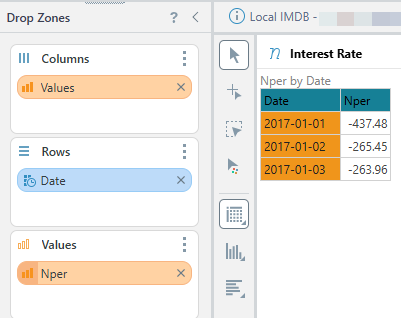 Nper (PQL)
Nper (PQL)
Returns the number of periods for an investment based on periodic, constant payments and a constant interest rate.
- Returned Output: Numeric
- Library: PQL \ Common \ Financial
- Version: 2025.01.000
- Compatibility:
- It can be combined with other PQL functions throughout the application.
- It CANNOT be used with MDX or VBA functions. But it can be used on MDX-based content in other parts of the application.
Syntax
* Click on the function's arguments above for more details on the input values.
Comments
This function is the same as the Microsoft Excel 'NPER' function - using the same inputs, logic, and outputs.
Function Arguments
|
Name |
Description |
Type |
Optional |
|
rate |
Interest rate expressed as percentage (per period). |
<Numeric> |
|
|
pmt |
Payment made each period; cannot change over life of the annuity. |
<Numeric> |
|
|
pv |
Present value. |
<Numeric> |
|
|
fv |
Future value; if omitted, the calculation uses zero (0). |
<Numeric> |
Y |
|
type |
Indicates when payments are due; at the end (0) or beginning (1) of the period; if omitted, the calculation uses the end (0). |
Number ( <Boolean>) |
Y |
Note: Literal encoding is in use; this means that Booleans and Dates are represented as numeric values (1 and 0 and timestamps or serial date numbers, respectively).
Example
This example calculates how many periods it would take to fully repay or grow the [Data Sales] amount, if I make $12 payments every period at 0.5% interest:
Nper( 0.05, 12, [measures].[Data Sales] )
